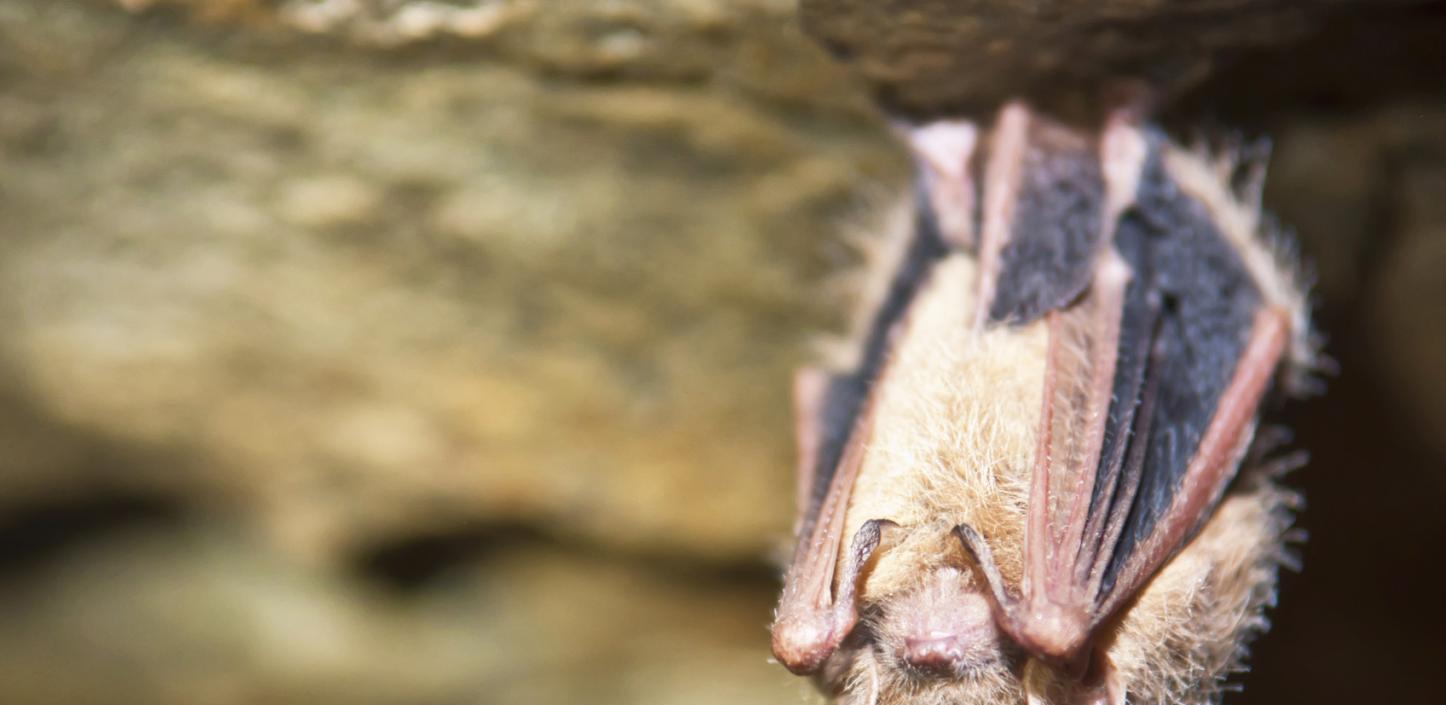
NFWF Announces $770,000 in Grants to Help Bats in their Fight Against White-nose Syndrome
Four grants awarded to help organizations advance the fight against white-nose syndrome
WASHINGTON, D.C. (October 21, 2021) – The National Fish and Wildlife Foundation (NFWF) today awarded $770,000 in grants to four projects to combat white-nose syndrome, a disease that is devastating bat populations in North America. The grants were awarded through the Bats for the Future Fund, with support from the U.S. Fish and Wildlife Service, as well as Southern Company and the Avangrid Foundation.
"The Bats for the Future Fund supports the development of management strategies that show potential to improve bat survival and help affected populations recover from white-nose syndrome," said Dr. Jeremy Coleman, national white-nose syndrome coordinator for the U.S. Fish and Wildlife Service. "These four new grants continue to advance this urgent and impactful work."
Over the past decade, white-nose syndrome has killed millions of bats, which are an important part of healthy natural environments, consuming billions of insects, including many agricultural pests. White-nose syndrome is caused by an invasive, cold-loving fungus that attacks hibernating bats, causing them to burn through winter fat stores and starve.
More than half of the bat species in the United States and Canada hibernate to survive the winter, making them potentially susceptible to the disease. Since signs of white-nose syndrome were first observed in upstate New York in 2006, the disease has spread rapidly, moving steadily westward across the United States and Canada. It has now been confirmed in 37 states and seven Canadian provinces, with new detections each year.
"White-nose syndrome is a threat to the existence of a number of bat species native to North America and this challenge requires an all-hands-on-deck fight to help bats survive," said Jeff Trandahl, executive director and CEO of NFWF. "Together with the Fish and Wildlife Service, Southern Company and the Avangrid Foundation, I am confident that the grants we announce today will make a difference in the fight against this terrible disease."
This year’s Bats for the Future Fund recipients include:
- Rutgers, The State University of New Jersey will test the efficacy of using whole-room ultra-violet (UV) light treatment in ten mines that host hibernating populations of little brown bats in Michigan, New Jersey, and New York. The project will test the ability of commercially available UV technology to benefit bats by killing or slowing growth of the fungus in summer when bats are not present.
- Kennesaw State University in Georgia will create artificial cave environments to mimic bat hibernation conditions and evaluate the effectiveness of a range of aerosolized compounds in reducing growth of the fungus that causes white-nose syndrome. The project will test aerosolized versions of existing experimental treatments like polyethylene glycol (PEG) and volatile organic compounds (VOCs) and evaluate their use in future management.
- University of Saskatchewan will determine best management practices for conserving populations of little brown bats in agricultural landscapes at the leading edge of white-nose syndrome in the Northern Great Plains. The project will identify how agricultural practices and exposure to pesticides influence bat activity, condition, survival, and reproductive success. The research will be used to inform more effective targeting of conservation strategies for bat populations affected by white-nose syndrome.
- Bat Conservation International, Inc. will improve foraging conditions for bats as a long-term and scalable strategy to improve survival and aid recovery of bat populations impacted by white-nose syndrome. The project will determine if restoring native plant communities on rights of way in Illinois and West Virginia can increase available insect prey for bats, particularly during fall and spring.
"Protecting at-risk species and the places they call home is important," said Jesalyn McCurry, environmental stewardship manager at Southern Company. "From Georgia to New York and throughout North America, the Bats for the Future grants make research possible that will help us improve habitat for bats – today and for future generations."
"We know that combatting white-nose syndrome in bats is critical to protecting biodiversity and the ecosystems at the heart of the sustainable communities where we live and work," said Avangrid Vice President of Sustainability, Laney Brown. "Over the past four years as a partner to the BFF fund, we have collectively deepened our understanding of importance of this funding for research and programs, particularly as we experience a rapidly changing climate."
Since its inception in 2017, the Bats for the Future Fund has awarded more than $3.8 million in grants to support research and implement management strategies that slow the spread of white-nose syndrome and improve survival of bats across the U.S. and Canada. Grants are supporting collaborations among federal and state agencies, universities, non-governmental organizations and for-profit corporations, who have joined forces to prevent potential bat extinctions caused by this emerging wildlife disease.
To learn more about Bats for the Future Fund opportunities or to download the 2021 Bats for the Future Fund Grant Slate, visit www.nfwf.org/programs/bats-future-fund. To learn more about WNS, visit www.whitenosesyndrome.org.
About the National Fish and Wildlife Foundation
The National Fish and Wildlife Foundation (NFWF) works with the public and private sectors to sustain, restore and enhance the nation’s fish, wildlife, plants and habitats for current and future generations. Chartered by Congress in 1984, NFWF has grown to become the nation’s largest private conservation grant-maker, funding more than 19,700 projects and generating a total conservation impact of $6.8 billion. Learn more at www.nfwf.org.
About the U.S. Fish and Wildlife Service
The U.S. Fish and Wildlife Service works with others to conserve, protect, and enhance fish, wildlife, plants, and their habitats for the continuing benefit of the American people. For more information about our work and the people who make it happen, visit www.fws.gov. The public can also connect with our Facebook page, follow our tweets, watch our YouTube channel and download photos from our Flickr page.
# # #
Contact:
Rob Blumenthal, (202) 857-0166, rob.blumenthal@nfwf.org